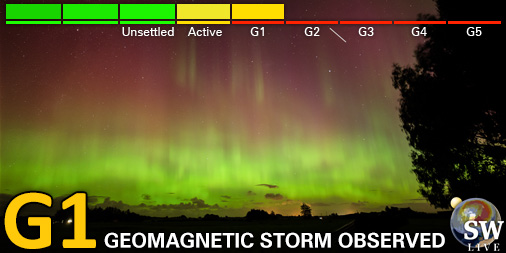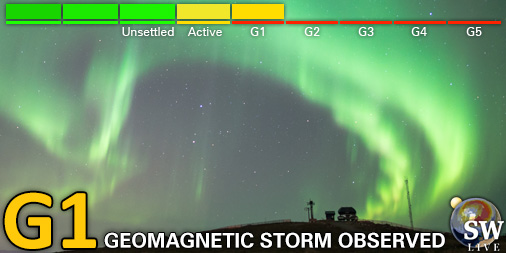Het archief bekijken van maandag 24 februari 2025
Dagelijks bulletin over zonne- en geomagnetische activiteit van het SIDC
Datum verslag: 2025 Feb 24 1253 UTC
SIDC Prognose
Zonnevlammen
M-class flares expected (probability >=50%)
Geomagnetisme
Active conditions expected (A>=20 or K=4)
Proton Flux monitor
Warning condition (activity levels expected to increase, but no numeric forecast given)
| 10cm flux | Ap | |
|---|---|---|
| 24 Feb 2025 | 211 | 014 |
| 25 Feb 2025 | 210 | 008 |
| 26 Feb 2025 | 210 | 006 |
Zonnevlekkengebieden en zonnevlammen
Solar flaring activity was at high levels over the past 24 hours with an impulsive X2.0-flare, start time 19:22 UTC, end time 19:34 UTC, peak time 19:27 UTC on Feb 23. The X-flaring was produced by SIDC Sunspot Group 410 (NOAA Active Region 4001) from the west limb. A total of 13 numbered sunspot groups were identified with SIDC Sunspot Group 409 (NOAA Active Region 4000) being the most complex region on the visible solar disc. It is classified as magnetic type beta-gamma- delta and has produced an impulsive M3.3-flare with peak time 07:02 UTC on Feb 24. Another very notable and rather large region is SIDC Sunspot Group 408 (NOAA Active Region 3998). It is classified as magnetic type beta-gamma and was responsible for multiple C-class and a low M-class flaring. The solar flaring activity is likely to be at moderate levels over the coming days with very likely M-class flares and 25% chances for X-flaring.
Coronale massa uitstoten
A fast partial-halo coronal mass ejection (CME) with a projected velocity close to 1900 km/s was first detected in the LASCO/C2 data at 19:48 UTC on Feb 23. The eruption is related to an X2.0 flare with peak time 19:27 UTC, produced by SIDC Sunspot Group 410 (NOAA Active Region 4001) from behind the west limb. The CME is estimated to be back-sided and is not expected to arrive at Earth. Another fast wide westward CME was visible in LASCO/C2 data at 06:12 UTC on Feb 24, accompanied by activity at the west limb as well as an on disc dimming and a related filament eruption in the north-west quadrant. Preliminary analysis suggests that the bulk of the CME is headed off the Sun-Earth line. Further analysis is ongoing to estimate any potential impacts at Earth.
Zonnewind
Over the past 24 hours the solar wind parameters (ACE and DSCOVR) reflected moderately disturbed solar wind conditions, possible related to an expected arrival of the CME from Feb 20. The magnitude of the interplanetary magnetic field, B, reached 15.5 nT with a minimum Bz of -9.6 nT. The solar wind speed varied between 300 and 400 km/s. The B field phi angle has switched orientation from the positive sector to the negative sector (directed towards the Sun). The solar wind conditions are expected to remain at slightly disturbed levels over the next 24 hours.
Geomagnetisme
The geomagnetic conditions over the past 24 hours were quiet to unsettled. Predominantly quiet to unsettled geomagnetic conditions are expected for the next 24 hours with chances for isolated active periods related to the ongoing solar wind disturbance at Earth.
Proton flux niveaus
Over the past 24 hours the greater than 10 MeV GOES proton flux has shown gradual enhancements possibly related to the fast coronal coronal mass ejection first detected in the LASCO/C2 data at 06:12 UTC on Feb 24. The greater than 10 MeV GOES proton flux is expected to exhibit further increase with some chances of reaching minor radiation storm levels over the 24 hours.
Elektronenfluxen in geostationaire baan
The greater than 10 MeV GOES 16 and GOES 18 electron flux has been below the 1000 pfu threshold over the last 24 hours and is expected to remain so in the next 24 hours. The 24-hour electron fluence was at normal levels and is expected to remain so in the next 24 hours.
Het geschatte internationale zonnevlekkengetal (ISN) van vandaag: 156, gebaseerd op 08 stations.Zon indexen voor 23 Feb 2025
| Wolfgetal Catania | /// |
| 10cm zonneflux | 210 |
| AK Chambon La Forêt | 014 |
| AK Wingst | 008 |
| Geschatte Ap | 007 |
| Geschat internationaal zonnevlekkengetal | 180 - Gebaseerd op 15 stations |
Overzicht opvallende gebeurtenissen
| Dag | Start | Max | Einde | Locatie | Sterkte | OP | 10cm | Catania/NOAA | Soorten radio-uitbarstingen |
|---|---|---|---|---|---|---|---|---|---|
| 23 | 1147 | 1158 | 1207 | ---- | M1.6 | --/4001 | |||
| 23 | 1618 | 1635 | 1651 | S12W23 | M1.0 | SN | 49/3998 | ||
| 23 | 1922 | 1927 | 1934 | ---- | X2.0 | --/4001 | III/2CTM/1 | ||
| 24 | 0133 | 0146 | 0155 | ---- | M1.3 | --/4001 | |||
| 24 | 0653 | 0702 | 0708 | ---- | M3.3 | 51/4000 | III/2II/2 |
Aangeboden door het Solar Influences Data Analysis Center© - SIDC - Verwerkt door SpaceWeatherLive
Alle tijden in UTC
<< Keer terug naar de dagelijkse overview pagina
Op basis van de huidige parameters is er in de nabije toekomst een beperkte kans op poollicht op de volgende locaties van de hoge breedtegraad
Iqaluit, NUNuuk
Reykjavik
Laatste nieuws
Laatste forumberichten
Steun Poollicht.be!
Om ook bereikbaar te blijven bij grote poollichtkansen hebben we een zware server nodig die alle bezoekers aankan. Doneer en steun dit project zodat we online blijven en je geen enkele poollichtkans mist!

Laatste alerts
zondag 6 april 2025
02:00 UTC - Geomagnetische activiteit
G1 - Kleine geomagnetische storm (Kp5) Drempel bereikt: 01:50 UTC
zaterdag 5 april 2025
20:30 UTC - Geomagnetische activiteit
G1 - Kleine geomagnetische storm (Kp5) Drempel bereikt: 20:20 UTC
20:24 UTC - Zonnevlam
Matige M1.05 zonnevlam
20:09 UTC - Radio blackout
Kleine R1 radio blackout gedetecteerd (≥M1 - momenteel: M1.05)
10:00 UTC - Hemisferisch vermogen
Het OVATION-model voorspelt dat het hemisferisch vermogen 78GW zal bereiken om 10:32 UTC
Ruimteweer feitjes
| Laatste X-klasse uitbarsting | 28/03/2025 | X1.1 |
| Laatste M-klasse uitbarsting | 05/04/2025 | M1.0 |
| Laatste geomagnetische storm | 05/04/2025 | Kp6- (G2) |
| Zonnevlekkenloze dagen | |
|---|---|
| Laatste zonnevlekkenloze dag | 08/06/2022 |
| Maandelijks gemiddeld zonnevlekkengetal | |
|---|---|
| maart 2025 | 134.2 -20.4 |
| april 2025 | 150.4 +16.2 |
| Afgelopen 30 dagen | 132.4 -10.1 |





